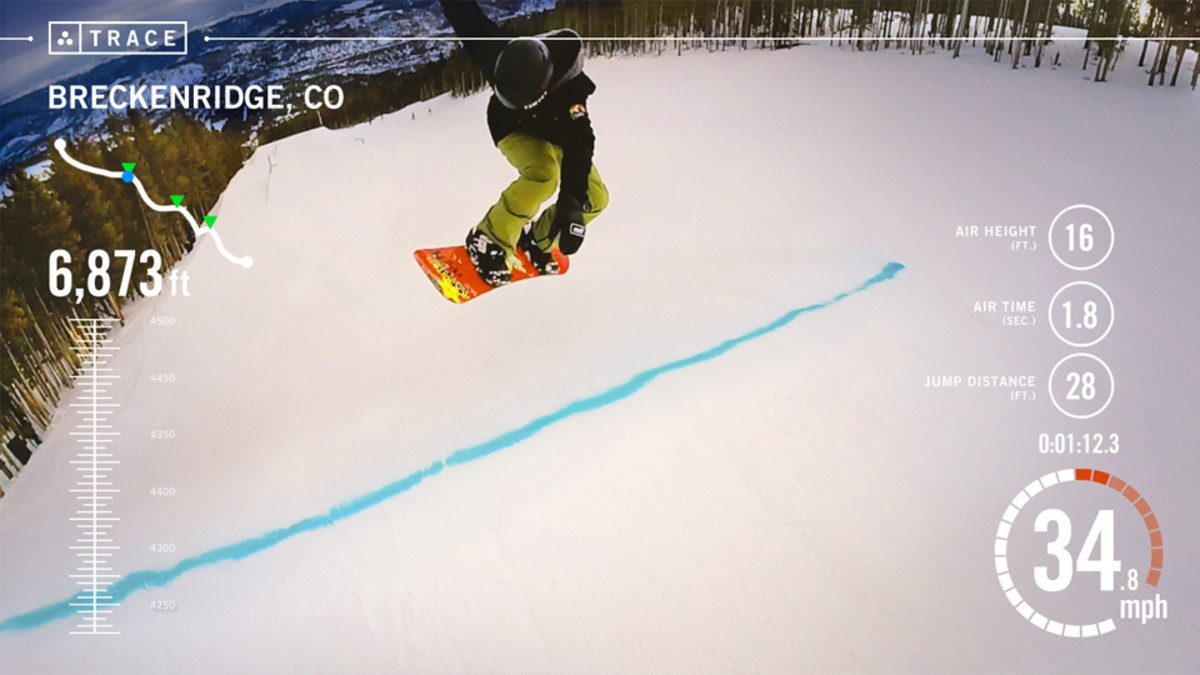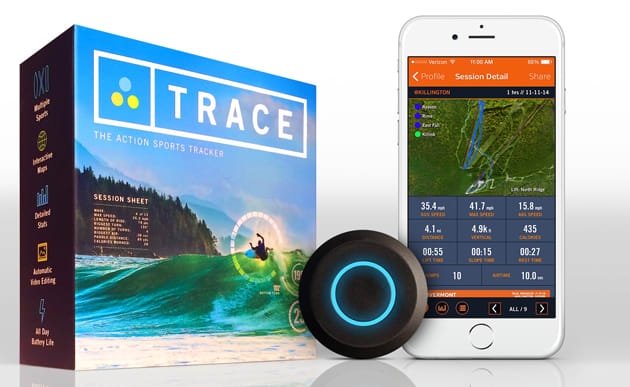Tech Talk: Trace offers unique data visualization for action sports video
If you're out for a run and looking to keep track of your mile splits or in the saddle pedaling up hill and eager to track your power output, you can choose from a variety of devices ready to deliver all manner of data. But curious about how much air you actually caught on that last snowboard jump? How many degrees of a turn did you make on that last wave? How fast were you going during that downhill stretch on your skis? Trace measures it all and then overlays that data on your GoPro or other video program to create a data-filled highlight reel.
What is it?
In the size of a Reese’s Peanut Butter Cup, this 1.4-ounce device mounts to any flat or slightly curved surface to track all the metrics your board (surf or snow) or ski covers. While measuring data while you recreate—or train—the Trace Cam function within the Trace apps also automatically and instantaneously creates a video highlight reel, working with GoPro, iPhone/iPad, Android and other video cameras.
How does it work?
Using high-frequency GPS, a nine-axis inertial measurement unit that includes an accelerometer, gyroscope and magnetometer, along with a computer, Bluetooth two ways and a 10-hour battery life, Trace uses algorithms from its “math team,” co-founder David Lokshin tells Edge’s Tech Talk, to track your every movement.
On the Road: Kelly Clark says to slow down and enjoy the culture
“We wanted to focus on sports that required sensor fusion,” he says about charting movement for snow and wave riders. “Take skiing for example: really high speeds, very quick turns even at the intermediate level, airtime, rotations and more. You can’t measure that with just a GPS.”
With the Bluetooth 2.1 and 4.0 function built in, Trace syncs with a GoPro (or other video product) to merge data to video, overlaying the data on the final highlight reel.
Why’s it significant?
“I grew up surfing and snowboarding,” Lokshin says. “My friends who were playing baseball or basketball knew their batting average and shooting percentage. I didn't really know anything about my improvement.”
Having the ability to track movement in a sport-specific way allows for those seeking adventure to compare their experiences to others they have had or to those of their friends. And those athletes using adventure sports as a performance outlet can examine the actual data post-run for training purposes.
What are the implications in the world of adventure sport and video?
Skip the performance aspect of data at first. Having a constant stream of cool information flowing with video makes for some pretty compelling views. Watching a recent Joss Christensen video while preparing for the X Games in Aspen, we see an example of how having Trace map runs, measure speed, vertical movement, total distance covered, resting time, air time and more (for the snow) keeps us more interested in the video.
For surfing, Trace will map your waves, give you a wave count and then measure speed, length of ride, number of turns, turns in degrees, paddle distance, air time and more.
Plus, Trace does the hard work of cutting out the boring stuff to give you the best you on video.
When you add performance needs back in, having a variety of data points to measure against gives science to the sport.
What are the downsides?
Khombu Apres Ski boots tailor-made to the U.S. Ski Team
Trace claims you can turn it on and go, meaning it will automatically cut your waves, edit your video and figure out which lift you’re on. “A lot of work goes into figuring that out,” Lokshin says. With more than 3.4 million hours of skiing and snowboarding in the system, that data all helps Traces data processing. But Trace is still new, having released in 2014, so expect more honing to happen as usage increases.
Of course, you won’t get much benefit out of Trace unless you’re actually out riding waves or racing the snow.
Who’s using it already?
X Games silver medalist Christensen has given us our first pro look at the device, so expect to see it pop up more, especially as the popularity of GoPro increases.
What’s the future of it going forward?
Lokshin says Trace, which started as a Kickstarter campaign in September 2013, aims to “help athletes improve and make it so that they never have to edit a video again.” With a relatively young company getting started in the world of tracing, expect Trace to track more as it keeps moving forward.
Trace will continue to pack in more data power into its small package. A tasty Reese’s for the technically advanced action sport adventurers.
Tim Newcomb covers stadiums, design and gear for Sports Illustrated. Follow him on Twitter at @tdnewcomb.






